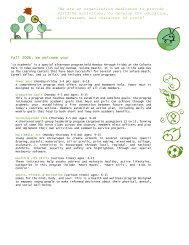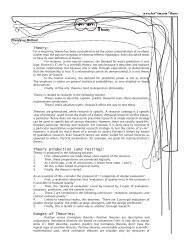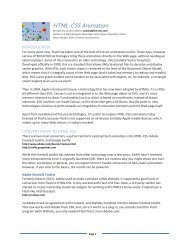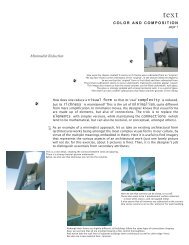ULTRAPERFORMING Beams/ Columns Doors ... - fen-om data
ULTRAPERFORMING Beams/ Columns Doors ... - fen-om data
ULTRAPERFORMING Beams/ Columns Doors ... - fen-om data
You also want an ePaper? Increase the reach of your titles
YUMPU automatically turns print PDFs into web optimized ePapers that Google loves.
that virtually every curtain wall will leak; it is only a matter of when, where, and what it will cost<br />
to fix. Developed by Dr. Raymond Ting, TingWall utilizes an “air loop” principle to neutralize the<br />
effects of both wind and rain by incorporating separate air and water seals. The result is a curtain<br />
wall system that can tolerate imperfect seals anywhere in the system and still not leak. TingWall<br />
has surpassed the most rigorous AAMA standards in multiple tests, and can withstand greater<br />
seismic and wind loads than a conventional system. TingWall is designed to allow for the use of<br />
multiple facing materials without edge conflicts, and is cost c<strong>om</strong>petitive with so-called “stick”<br />
systems.<br />
www.tingwall.c<strong>om</strong><br />
Water-Repelling Paint<br />
The leaves of the lotus flower are water-repellent. After a shower of rain they immediately appear<br />
dry and clean, as water runs off them like marbles off a glass plate. Lotusan has duplicated this<br />
effect, one of nature’s own inventions which has proved itself over millions of years, in a new<br />
silicone facade paint. Lotusan c<strong>om</strong>bines the well-known water-repellent properties of silicone<br />
paints with a surface micro-structure based on the lotus leaf. This considerably reduces the<br />
contact area for water and dirt, and adhesion is also greatly reduced. The result is that dirt<br />
is repelled by water droplets and facades stay dry and clean - even highly stressed weatherexposed<br />
facades. The lotus effect was discovered by Prof. Dr Wilhelm Barthlott of Bonn University,<br />
a scientific achievement in the field of biology which created a worldwide sensation.<br />
Wind Sculptures<br />
Ned Kahn is an acc<strong>om</strong>plished North California sculptor who deploys materials in order to celebrate<br />
and amplify natural forces. His large-scale wind installations, which have names like Wind Portal,<br />
Technorama Facade, and Fragmented Sea, utilize vast arrays panels made of aluminum, steel,<br />
and other materials to shimmer and dance in the breeze, allowing the natural environment<br />
to influence the design. In Articulated Cloud, for example, thousands of 9-inch squares of<br />
perforated aluminum are mounted on low friction hinges so that the entire surface of the facade<br />
responds to the wind. Each moving panel is perforated with thousands of different sized holes<br />
that, when viewed fr<strong>om</strong> a distance, create a photographic mosaic of sand dune images. When<br />
sunlight passes through the screens, intricate shadow images of the dunes are projected onto<br />
the walls and floor of the building lobby.<br />
http://nedkahn.c<strong>om</strong>/wind.html<br />
TRANSFORMATIONAL<br />
Materials which undergo a physical morphosis based on environmental<br />
stimuli.<br />
Glazing<br />
Lumisty Film<br />
Lumisty first drew widespread attention when it was used on the windows of Pleats Please, Issey<br />
Miyake’s clothing boutique in SoHo. Since then many of the world’s top designers and architects<br />
have opted to put the film at the service of their own rich imaginations, and the results have been<br />
stunning. Lumisty’s applications range fr<strong>om</strong> museums, hotels, banks, restaurants, and bars, to<br />
storefronts, conference ro<strong>om</strong>s, trade show exhibits-and even bathro<strong>om</strong>s. If you’ve seen Lumisty<br />
in action you’ve experienced the unexpected visual sensation it creates. Upon first encountering<br />
the product, people are often struck by what they think is an optical illusion. Walking past a<br />
window with Lumisty applied, a perfectly clear, transparent glass surface bec<strong>om</strong>es, in a step<br />
or two, partially fogged. Two or three steps later, the same window is c<strong>om</strong>pletely fogged. Walk<br />
backward or forward, and it’s clear again. As the viewer’s angle shifts, so does the transparency<br />
or translucency of the film.<br />
www.lumistyfilm.c<strong>om</strong>/lumisty.htm<br />
SmartGlass<br />
Suspended Particle Device (SPD) technology is a “switchable” light-control technology that has<br />
numerous performance and cost advantages over other technologies. SPD-Smart products allow<br />
you to instantly and precisely control how clear or dark glass or plastic is, and to easily adjust<br />
the light transmission of the product manually or aut<strong>om</strong>atically. This is made possible by a thin,<br />
flexible SPD film invented by Research Frontiers. Available as a film or already incorporated into<br />
glass, SPD film can be easily adapted to a variety of products that people use every day, such as<br />
architectural windows, aut<strong>om</strong>otive windows, sunglasses, display screens for laptop c<strong>om</strong>puters,<br />
cellular telephones, instrument panels, electronic games and point-of-purchase and advertising








